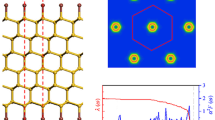Abstract
Properties of the interface between Si(111) and 3C–SiC(111) grown by the method of coordinated substitution of atoms have been studied using the density-functional method within the spin-polarized approximation. The most favorable atomic configuration at the interface has been found. It is shown that SiC faces Si with a carbon plane, and SiC detaches 3 out of 16 Si atoms from the second layer of substrate atoms. As a result, three Si atoms in the substrate have three bonds each (instead of four), while three C atoms in the lower layer of the SiC film also have three bonds. These atoms have a magnetic moment owing to unpaired p electrons. It is established that this interface is a typical semiconductor with respect to up-spin electron and a two-dimensional ferromagnetic metal relative to down-spin electron.



Similar content being viewed by others
REFERENCES
T. Kimoto and J. A. Cooper, Fundamentals of Silicon Carbide Technology: Growth, Characterization, Devices and Applications (Wiley-IEEE, Singapore, 2014), p. 75.
N. T. Son, C. P. Anderson, A. Bourassa, K. C. Miao, Ch. Babin, M. Widmann, M. Niethammer, J. Ul. Hassan, N. Morioka, I. G. Ivanov, F. Kaiser, J. Wrachtrup, and D. D. Awschalom, Appl. Phys. Lett. 116, 190501 (2020). https://doi.org/10.1063/5.0004454
A. Boretti, Nat. Photon. 8, 88 (2014). https://doi.org/10.1038/nphoton.2013.375
H. J. von Bardeleben, S. A. Zargaleh, J. L. Cantin, W. B. Gao, T. Biktagirov, and U. Gerstmann, Phys. Rev. Mater. 3, 124605 (2019). https://doi.org/10.1103/PhysRevMaterials.3.124605
S. A. Kukushkin and A. V. Osipov, J. Phys. D: Appl. Phys. 47, 313001 (2014). https://doi.org/10.1088/0022-3727/47/31/313001
S. A. Kukushkin and A. V. Osipov, J. Phys. D: Appl. Phys. 50, 464006 (2017). https://doi.org/10.1088/1361-6463/aa8f69
L. M. Sorokin, N. V. Veselov, M. P. Shcheglov, A. E. Kalmykov, A. A. Sitnikova, N. A. Feoktistov, A. V. Osipov, and S. A. Kukushkin, Tech. Phys. Lett. 34, 992 (2008).
N. T. Bagraev, S. A. Kukushkin, A. V. Osipov, V. V. Romanov, L. E. Klyachkin, A. M. Malyarenko, and V. S. Khromov, Semiconductors 55, 137 (2021). https://doi.org/10.1134/S106378262102007X
N. T. Bagraev, S. A. Kukushkin, A. V. Osipov, and V. L. Ugolkov, Semiconductors 56, 321 (2022). https://doi.org/10.1134/S1063782622070016
T. Tsuneda, Density Functional Theory in Quantum Chemistry (Springer, Tokio, 2014), p. 65.
U. von Barth and L. Hedin, J. Phys. C: Solid State Phys. 5, 1629 (1972). https://doi.org/10.1088/0022-3719/5/13/012
J. P. Perdew, K. Burke, and M. Ernzerhof, Phys. Rev. Lett. 77, 3865 (1996). .https://doi.org/10.1103/PhysRevLett.77.3865
J. Hafner, J. Comput. Chem. 29, 2044 (2008). https://doi.org/10.1002/jcc.21057
F. Tran and P. Blaha, Phys. Rev. Lett. 102, 226401 (2009). https://doi.org/10.1103/PhysRevLett.102.226401
J. Kudrnovsky, I. Turek, V. Drchal, F. Maca, J. Masek, P. Weinberger, and P. Bruno, J. Supercond. 16, 119 (2003). https://doi.org/10.1023/A:1023257306608
ACKNOWLEDGMENTS
A.V. Osipov and E.V. Osipova acknowledge the support of the Ministry of Science and Higher Education of the Russian Federation within the framework of state order no. FFNF-2021-0001 for the Institute for Problems in Mechanical Engineering of the Russian Academy of Sciences. S.A. Kukushkin acknowledge the support of the Ministry of Science and Higher Education of the Russian Federation within the framework of state order no. 75746688 for St. Petersburg State University.
Author information
Authors and Affiliations
Corresponding author
Ethics declarations
The authors declare that they have no conflicts of interest.
Additional information
Translated by A. Sin’kov
Rights and permissions
About this article
Cite this article
Kukushkin, S.A., Osipov, A.V. & Osipova, E.V. Spintronic Properties of the Interface between Si(111) and 3C–SiC(111) Grown by the Method of Coordinated Substitution of Atoms. Tech. Phys. Lett. 48, 263–267 (2022). https://doi.org/10.1134/S1063785022090036
Received:
Revised:
Accepted:
Published:
Issue Date:
DOI: https://doi.org/10.1134/S1063785022090036




